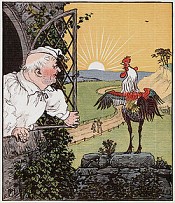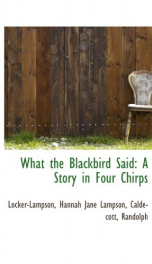Locker-Lampson Hannah Jane

Randolph Caldecott (22 March 1846 – 12 February 1886) was a British artist and illustrator, born in Chester. He was the eponym of the Caldecott Medal. He exercised his art chiefly in book illustrations. His abilities as an artist were promptly and generously recognized by the Royal Academy. Caldecott greatly influenced illustration of children's books during the nineteenth century. Two books illustrated by him, priced at a shilling each, were published each Christmas for eight years. Caldecott's output, however, ranged wider than this: he illustrated novels and accounts of foreign travel, made humorous drawings depicting hunting and fashionable life, drew cartoons and he made sketches of the famous Parliament inside and out, and exhibited sculptures and paintings in oil and watercolour in the Royal Academy and galleries. Caldecott was born at 150 Bridge Street (now No 16), Chester, where today there is a plaque to commemorate him. His father, John Caldecott, was a Chester businessman and an accountant of some note who was married twice and had 13 children. Caldecott was his third child by his first wife Mary Dinah (née Brookes). In 1848 the family moved to Challoner House, Crook Street and in 1860 to 23 Richmond Place at Boughton just outside Chester. He spent the last five years of his schooling at The King's School which, in those days, was in the cathedral buildings in the centre of the city. In his early childhood Caldecott drew and modelled, mostly animals, and he continued drawing for the rest of his life. There is a small oil painting in Chester of his brother Alfred painted during his school days. On leaving school at the age of fifteen, Caldecott went to work at the Whitchurch branch of the Whitchurch & Ellesmere Bank and took lodgings at Wirswall, a village near the town. In his spare time and when he was out visiting clients he was often to be seen walking and riding around the countryside; many of his later illustrations incorporate buildings and scenery of that part of Cheshire. His love of riding led him to take up hunting and his experiences in the hunting field and his love of animals bore fruit over the years in the masses of drawings and sketches of hunting scenes, many of them humorous. In the year that he left school, 1861, he first had a drawing published: it was a sketch of a disastrous fire at the Queen Railway Hotel in Chester and it appeared in the Illustrated London News together with his account of the blaze. After six years at Whitchurch, Caldecott moved to the head office in Manchester of the Manchester & Salford Bank. He lodged variously in Aberdeen Street, Rusholme Grove and at Bowdon. He took the opportunity to study at night school at the Manchester School of Art and practised continually, with success in local papers and some London publications. It was a habit of his at this time, which he maintained all his life, to decorate his letters, papers and documents of all descriptions with marginal sketches to illustrate the content or provide amusement. A number of his letters have been reprinted with their illustrations in Yours Pictorially, a book edited by Michael Hutchings. In 1870, through a friend in London, the painter Thomas Armstrong, Randolph was put in touch with Henry Blackburn the editor of London Society, who published a number of his drawings in several issues of the monthly magazine. Encouraged by this evidence of his ability to support himself by his art, Caldecott decided to quit his job and move to London; this he did in 1872 at the age of 26. Within two years he had become a successful magazine illustrator working on commission. His work included individual sketches, illustrations of other articles and a series of illustrations of a holiday which he and Henry Blackburn took in the Harz Mountains in Germany. The latter became the first of a number of such series. He remained in London for seven years, spending most of them in lodgings at 46 Great Russell Street just opposite the British Museum, in the heart of Bloomsbury. While there he met and made friends (as he did very readily) with many artistic and literary people, among them Dante Gabriel Rossetti, George du Maurier (who was a fellow contributor to Punch), John Everett Millais and Frederic Leighton. His friendship with Frederic (later Lord) Leighton led to a commission to design peacock capitals for four columns in the Arab room at Leighton's rather exotic home, Leighton House in Kensington. (Walter Crane designed a tiled peacock frieze for the same room.) In 1869 Caldecott had a picture hung in the Royal Manchester Institute. He had a picture hung in the Royal Academy for the first time in 1876. He was also a water colourist and was elected to the Royal Institute of Watercolour Painting in 1872. In 1877 Edmund Evans, who was a colour printer and talented engraver, lost the services of Walter Crane as his children's book illustrator and asked Caldecott to do illustrations for two books for Christmas. The results were The House that Jack Built and The Diverting History of John Gilpin, published in 1878. They were an immediate success; so much so that he produced two more each year until he died. The stories and rhymes were all of Caldecott's choosing and in some cases were written or added to by himself. In another milieu Caldecott followed The Harz Mountains with illustrations for two books of Washington Irving's, three for Juliana Ewing, another of Henry Blackburn's, one for Captain Frederick Marryat and for other authors. Among well known admirers of his work were Gauguin and Van Gogh. Randolph continued to travel, partly for the sake of his health, and to make drawings of the people and surroundings of the places he visited; these drawings were accompanied by humorous and witty captions and narrative. In 1879 he moved to Wybornes, a house which he took (it is not known whether he bought or rented it) near Kemsing in Kent. It is there that he became engaged to Marian Brind, who lived at Chelsfield about seven miles away. They were married in 1880 and lived at Wybornes for the next two years. There were no children of the marriage. In the autumn of 1882 the Caldecotts left Kent and bought a house, Broomfield, at Frensham in Surrey; they also rented No 24 Holland Street, Kensington. By 1884, sales of Caldecott's Nursery Rhymes had reached 867,000 copies (of twelve books) and he was internationally famous. However, his health was generally very poor and he suffered much from gastritis and a heart condition going back to an illness in his childhood. It was his health among other things which prompted his many winter trips to the Mediterranean and other warm climates. It was on such a tour in the United States of America in 1886 that he was taken ill again and succumbed. He and Marian had sailed to New York and travelled down the East Coast; they reached Florida in an unusually cold February; Randolph was taken ill and died at St. Augustine. He was not quite 40 years old. A headstone still marks his grave in the cemetery there. Soon after his early death, his many friends contributed to a memorial to him which was designed by Sir Alfred Gilbert. It was placed in the crypt of St Paul's Cathedral, London. There is also a memorial to him in Chester Cathedral. Gleeson White wrote of Caldecott: In his Prophets Priests and Kings (London: Alston Rivers, 1908, p. 327), A. G. Gardiner, editor of the Daily News, showed his appreciation of the importance of Caldecott's illustrations when he quoted a short poem that G. K. Chesterton had inscribed in "a book of Caldecott's pictures to a little friend of mine—" Online collections Misc Engen, Rodney K. (1988) Randolph Caldecott: Lord of the Nursery, London: Bloomsbury Publishing ISBN 1870630459 This article incorporates text from the public domain 1907 edition of The Nuttall Encyclopædia.
do you like this author?
What readers are saying
What do you think? Write your own comment on this book!
write a commentWhat readers are saying
What do you think? Write your own comment on this author!
write a commentBook list

What the Blackbird said
Series:
Unknown
Year:
Unknown
Raiting:
3.5/5
With the exception of the Scotch firs and other fortunate evergreens,there was nothing to be seen on all sides but leafless branches standingout sharply against the cold, grey sky. The ground was frozen, andentirely covered with snow, for there had been a heavy fall during thenight. The way-marks of field and road were obliterated, all was onesheet of dazzling whiteness. Here and there a little mound marked thespot where a flower-bed lay buried, and there was one narrow path wherethe snow was thickly piled on either side, for it had been partiallyswept from the centre, which showed traces of the bright brown gravelbelow.
Show more
add to favoritesadd In favorites
Book list

What the Blackbird said
Series:
Unknown
Year:
Unknown
Raiting:
3.5/5
With the exception of the Scotch firs and other fortunate evergreens,there was nothing to be seen on all sides but leafless branches standingout sharply against the cold, grey sky. The ground was frozen, andentirely covered with snow, for there had been a heavy fall during thenight. The way-marks of field and road were obliterated, all was onesheet of dazzling whiteness. Here and there a little mound marked thespot where a flower-bed lay buried, and there was one narrow path wherethe snow was thickly piled on either side, for it had been partiallyswept from the centre, which showed traces of the bright brown gravelbelow.
Show more
add to favoritesadd In favorites
What readers are saying
What do you think? Write your own comment on this author!
write a commentif you like Locker-Lampson Hannah Jane try:
readers also enjoyed
What readers are saying
What do you think? Write your own comment on this author!
write a commentif you like Locker-Lampson Hannah Jane try:
readers also enjoyed
Do you want to exchange books? It’s EASY!
Get registered and find other users who want to give their favourite books to good hands!

